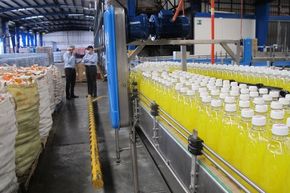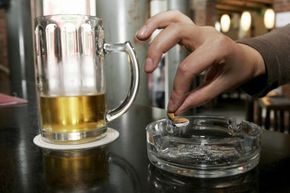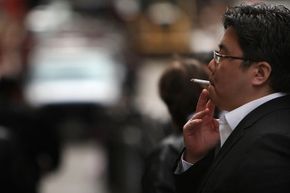 “"Sin tax" is another name for an excise tax, and it’s intended to help you behave.REMY GABALDA/AFP/Getty Images
“"Sin tax" is another name for an excise tax, and it’s intended to help you behave.REMY GABALDA/AFP/Getty Images
In 2012, New York City Mayor Michael Bloomberg was big on promoting public health. He successfully pushed to ban smoking in public spaces, and then he went after artificial trans fats, which are known to be carcinogenic. Soon you couldn’t get a drop of artificial trans fats in an NYC restaurant. And if that frustrated you, you couldn’t calm yourself with a smoke, either.
All was not lost, however. You could still fill up on a mega-dose of sweet, bubbly soda anywhere in the city. But Mayor Bloomberg’s anti-obesity campaign began zeroing in on super-sized helpings of delicious pop. In May 2012, he announced a plan to ban the sale of soft drinks that were served in portions over 16 fluid ounces (473 milliliters) [source: Grynbaum].
The reason? Medical researchers had been saying for some time that the steady rise in American obesity was linked in part to the steady intake of liquid sugar (e.g., soda). Bloomberg’s idea was to reduce the amount of soft drinks consumed and thereby reduce obesity, widely considered a major health issue.
Sin taxes are often considered a favorite tool of liberals out to impose a nanny state on free-thinking individuals. Conservatives often oppose sin taxes on the grounds that they amount to greater government intervention in people’s lives.
Accordingly, conservative critics weighed in, opining that the ban was an infringement on New Yorkers’ personal right to drink as much gosh darn soda as they wanted. But it wasn’t only conservatives who took umbrage. The comedian Jon Stewart, then host of "The Daily Show," was outraged by the proposed ban, saying that forbidding soft drinks was draconian and it wouldn’t have the desired effect [source: Friar]. If even Jon Stewart, usually associated with liberal politics, was against Bloomberg’s plan, did it have a future?
Turns out, it didn’t. The soft drink industry threw millions of dollars into an ad campaign designed to counter the ban, and they simultaneously mounted a legal challenge. In June 2014, New York’s final court of appeals struck down the ban in a definitive ruling [source: Grynbaum].
And that was the end of that. Or was it? Bloomberg mulled it over and decided he’d gone about it the wrong way. When you ban stuff that people like, it peeves them. But what if you just made that stuff a little more expensive by, say, adding a little wafer-thin tax to it? Would that have an effect?
In late 2014, Bloomberg, who also happens to be a billionaire, helped fund a campaign in Berkeley, California, to add an excise tax on soft drinks. Despite a $1.7 million counter-campaign by the soda industry, voters approved the measure, and Berkeley became the first jurisdiction in the U.S. to try out a soda tax. The tax adds a penny per ounce (30 milliliters) to sweetened drinks, including soda and iced tea.
According to the American Journal of Public Health, the tax worked, at least in the short-term. Measuring soda intake over a five-month period after the tax was implemented, researchers found that low-income and minority Berkeley residents drank 21 percent less than they had before. By contrast, over the same period in nearby cities that hadn’t added the tax, like San Francisco, consumption went up by 4 percent.
The tax Berkeley added to soft drinks is a type of excise tax often referred to as a "sin tax." It’s not a new idea. In fact, it’s a pretty old one.
Contents
- Sins of the Past
- Do Sin Taxes Work?
- Regressive/Progressive
- Sin-less
Sins of the Past
 “George Mason was a delegate to the Constitutional Convention and one of only three men who refused to sign the Constitution because it didn’t contain a Bill of Rights at the time.Smith Collection/Gado/Getty Images
“George Mason was a delegate to the Constitutional Convention and one of only three men who refused to sign the Constitution because it didn’t contain a Bill of Rights at the time.Smith Collection/Gado/Getty Images
As indicated earlier, sin taxes are taxes on stuff we like but that society thinks we probably shouldn’t have, at least not in large quantities. And they’ve been around for a long time, too. In fact, between 1863 and 1913, 90 percent of the U.S. government’s revenue came from taxes on sinful substances like smokes, wine, beer and liquor [source: IRS]. In case you’re wondering what happened in 1913, that was the year income tax became a thing. A sin tax is not an official category; it’s a popular name for an excise tax levied on products thought to be costly to society.
It’s interesting that the American government’s reliance on sin taxes started in 1863 because almost exactly a century earlier in 1764 the British Empire’s imposition of a sugar tax on the American colonies was one of the sparks that lit the revolutionary flame.
The main purpose of the sugar tax was to generate revenue for the king’s coffers, but it was also an attempt to kill two birds with one stone. The American colonists weren’t just using sugar to sweeten their porridge; they were using it to make rum. Lots of rum. In fact, the colonies had a reputation for excessive rum intake, and upon this practice the crown frowned [source: Newkirk]. Needless to say, the new tax was unpopular and when, a decade or so later, the Brits threw a stamp tax on top of it, things got ugly.
Even Bloomberg’s experience with banning versus taxing played out long ago at the very founding of the United States. As the Founding Fathers met in Philly to hash out the Constitution, a gentleman from Virginia named George Mason argued that Congress should be able to enact something called "sumptuary laws."
Sumptuary laws have been the tools of European and Asian lawmakers since ancient times. Usually, they took the form of preventing commoners from buying bling and throwing ridiculous parties. On the one hand, such laws helped prevent the masses from squandering their hard-earned money on useless trinkets. On the other, sumptuary laws effectively served to maintain class distinctions (and make sure you had money available for tithing). The idea was that it was important to be able to tell a rich and powerful person from an impoverished peon. If poor people could dress in fancy garb, everybody would be confused, and who knew what shenanigans would ensue? (Remember "The Prince and the Pauper"?) Queen Elizabeth I, for instance, was a big fan of sumptuary laws as she found it intolerably baffling when common people got gussied up like aristocrats [source: Crossen].
To be fair, back at the Constitutional Convention, George Mason didn’t say he wanted sumptuary laws for the maintenance of class distinctions, but rather to improve the general conduct of Americans. In other words, he didn’t want the citizens of the new republic to be too flashy. But his fellow delegates didn’t agree. Taxes, they said, were better than laws [source: Crossen].
That could be true, but it’s setting the bar low. Do sin taxes really work?
Do Sin Taxes Work?
 “Pineapple sodas are produced in the Oaxaca factory of Gugar Soda.The Washington Post/Getty Images
“Pineapple sodas are produced in the Oaxaca factory of Gugar Soda.The Washington Post/Getty Images
When lawmakers impose sin taxes these days, the official goals are to improve health outcomes, reduce the negative impacts of the taxed substance and raise a little revenue while they’re at it. There seems to be some evidence that the second and third goals can be achieved, but as to the first, the jury is still out.
Although Berkeley was the first jurisdiction in the U.S. to implement a soda tax, it’s not the first place in the world to do it. It’s not even the first in North America. As of 2014, the entire country of Mexico has a peso-per-liter tax on soft drinks and a tax of 8 percent on junk food. Consumption of both categories of food and drink have fallen dramatically [source: Newkirk]. But we don’t yet know whether the national rate of obesity has changed, or whether people are any healthier as a result of the tax. The problem here is that eating sugar and junk food isn’t the only way to become obese and/or unhealthy. In other words, success could depend on which sin you tax.
Take cigarettes. Not only does taxing them cut consumption, but if the tax is high enough, health outcomes even improve a bit. A sin tax on cigarettes can lower incidences of lung cancer, heart attacks and strokes. Not by a lot, but enough to make it worthwhile. Presumably, some of the negative effects of secondhand smoke would also be diminished at the same time.
Taxing alcohol would seem to be even more effective. Back in 2009 the state of Illinois made each bottle of beer more expensive by 1 cent and each serving of hard liquor by 5 cents. Amazingly, a study found that for each month after the implementation of the new taxes, deaths associated with drunk-driving dropped by 25 percent in the general population and 37 percent for young people [source: Newkirk]. Researchers expected to find that hardcore drinkers wouldn’t be affected by the tax, figuring their compulsion to imbibe would be impervious to small price increases. But to everybody’s surprise, drunk-driving deaths went down even for this category of drinker [source: Newkirk].
Sounds like great news, but skeptics, like mathematics professor Rebecca Goldin, have taken a second look at the data and raised serious concerns about the conclusions stated above. In her view, correlation does not equal causation. She argues the decline in traffic deaths is not specific to alcohol-related crashes, but is part of a general trend unrelated to drinking [source: Goldin].
So maybe some sin taxes can work if they tax the right sin, but maybe they don’t. Taxing cigarettes and alcohol is popular in part because smoking and drinking are perceived to be not only unhealthy for the individual consuming them, but also for the public at large (e.g., secondhand smoke, drunk-driving accidents, domestic abuse, etc.).
It isn’t quite as clear how people who choose to drink soda and eat unhealthy food are harming anyone other than themselves. It’s been argued that society bears the cost of the medical consequences of an unhealthy diet, but that could be said of many lifestyle choices, including sloth. It’s well known that lack of exercise is bad for our health. Should we be taxed for laziness?
Some Sin Tax Stats
As of 2014, the U.S. states that collect the most sin taxes were Rhode Island, Nevada, West Virginia, New Hampshire and Delaware. Nationally, in that same year, sin taxes brought in a total of $32 billion [source: Governing]. Here’s the breakdown: Tobacco: nearly $17 billion // Alcohol: more than $6 billion // Casinos: $5.5 billion // Racinos: just over $3 billion // Video gaming/Pari-mutuel betting: a little more than $700 million
Regressive/Progressive
 “Some sin-tax skeptics take issue with the disproportionate burden they place on the poor.SASCHA SCHUERMANN/AFP/Getty Images
“Some sin-tax skeptics take issue with the disproportionate burden they place on the poor.SASCHA SCHUERMANN/AFP/Getty Images
We’ve established that sin taxes can and do work under the right circumstances, but should they be a tool in the government’s taxation toolbox? One argument against the use of sin taxes is that they’re a regressive tax, one that affects the poor more than the rich.
On the one hand, this argument seems to be a no-brainer, since a sin tax is a form of sales tax, and sales taxes almost always hit poor people harder than wealthy people. That is, unless the tax is specifically aimed at the stuff rich people like to buy, like yachts or luxury cars. Such taxes exist, but they’re usually called luxury taxes. Whereas sin taxes cover the things the IRS deems dangerous, luxury taxes are levied on high-price items deemed nonessential.
Are sin taxes regressive? Maybe. Take, for example, taxes on cigarettes. As of 2016, a New Yorker has to pay a total of $5.85 in state and municipal taxes on each pack of cigarettes. Then add $1.01 in federal excise tax, bringing it $6.86. If said New Yorker smokes a pack a day, that amounts to more than $2,500 a year in cigarette taxes alone [source: New York State]. Proportionally, that’s much more of a hit for a low-income person than for somebody with plenty of dough.
Of course, the purpose of the tax is to force people to cut back on their habit, or quit altogether. Everybody knows that smoking is one of the worst things you can do for your health, so if you don’t like paying heaps of tax, smoke less. It’s that simple. At least that’s the argument of sin tax proponents. And in this case, they have a point. As we saw earlier, raising taxes on cigarettes does seem to reduce the amount people smoke, and this is particularly true for poor people. This is good news in that the poor typically smoke more than the rich [source: Remler].
Taken together, these factors are the grounds for some arguments that taxes on cigarettes are actually progressive rather than regressive. The idea is that they have progressive effects on the health of poor people because of, not despite, the fact that they cause more financial hardship for those with low incomes.
But even if you find this argument compelling, there are still reasons for skeptics to reject the idea of sin taxes.
Sin-less
 “A new federal sin tax on tobacco started April 1, 2009, driving the per-pack tax from 39 cents to $1.01. The tax affected all tobacco products, including cigars and pipes, and the money earned will be used to expand health coverage for low-income kids.Spencer Platt/Getty Images
“A new federal sin tax on tobacco started April 1, 2009, driving the per-pack tax from 39 cents to $1.01. The tax affected all tobacco products, including cigars and pipes, and the money earned will be used to expand health coverage for low-income kids.Spencer Platt/Getty Images
Sticking with the cigarette tax example, skeptics argue that while cig sin taxes might be able to reduce smoking to a point, there seems to be a limit. If you keep upping the ante, the reductions often start levelling off. The reason for this is that some people just won’t, or can’t, quit, and since these same people are often poor, they can’t afford to continue to buy cigarettes — legally.
In the early 1990s, the Canadian government sharply increased the tax rate on cigarettes. The hike was too steep, and it spawned a giant black market in contraband cigarettes. While black market sales of cigarettes accounted for only 1 percent of sales in 1987, they high-jumped to 31 percent in 1993. That’s a result nobody wants. Not only does it mean the tax isn’t having its desired effect on public health, it also means lost revenues. In 1994 Canada abruptly cut its sin taxes on cigarettes, a measure that helped reduce contraband sales and bring legal sales (and revenues) back up [source: Kelly-Gagnon].
This question of revenues is a big one. If you decide to raise a tax on a "sinful" product, you have to have a plan for what to do with the money that comes in. Often, the revenue is allocated for spending on health care. In some ways, this seems like an elegant, win-win solution. But sometimes it backfires.
In February 2009, Arkansas nearly doubled its tax on cigarettes to $1.15. The state had lots of great health-related plans for the projected $86 million in revenue this measure would bring in. But to the astonishment of legislators, rather than having more money, they ended up with $10 million less than they’d collected the previous year. The reason? Increased black market sales plus the more expedient (and legal) solution of simply crossing state lines to buy cheaper cigarettes [source: Moser].
And this brings us to yet another objection to sin taxes. Remember how the U.S. government was largely dependent on sin taxes for revenue up until 1913? That’s no longer the case, but some sin-tax skeptics estimate that taken together, both state and federal governments collect $96 billion annually from our bad behavior [source: Otero]. This, they argue, puts government in a moral bind. On the one hand, they impose the taxes to encourage people to sin less, while on the other, the government then comes to depend on the income from all that sinful spending. In other words, lawmakers have to hope that people will behave better, but not too much.
Lots More Information
Author’s Note: How Sin Taxes Work
In researching this article I came across "racinos" — about which I was completely ignorant. A racino, as probably everybody but me knows, is where a casino meets a racetrack. Such a simple but brilliant synthesis bundles a wide range of vices into a tidy package, making it easier than ever before to sin, and nearly effortless to collect the accompanying tax.
Related Articles
- How much sugar do they really put in soft drinks?
- How Income Taxes Work
- How Nicotine Works
- How Alcohol Works
- How State Sales Taxes Work
More Great Links
- Mothers Against Drunk Driving
- American Cancer Society
Sources
- Austin, Henry. "Nanny State Index: ‘Excessive’ regulation and ‘sin taxes’ make UK the worst place in the EU to be a wine drinker or smoker." Independent. March 31, 2016. (Oct. 13, 2016) http://www.independent.co.uk/news/uk/home-news/nanny-state-index-excessive-regulation-and-sin-taxes-make-britain-the-worst-place-to-live-in-the-eu-a6962671.html
- Brumby, Jim. "The seven salvos of sin (taxes)." The World Bank. March 25, 2014. (Oct. 13, 2016) http://blogs.worldbank.org/health/seven-salvos-sin-taxes
- Chaloupka, Frank J. et al. "Effects of Price on Alcohol Consumption and Alcohol-Related Problems." NIH, National Institute on Alcohol Abuse and Alcoholism. (Oct. 12, 2016) http://pubs.niaaa.nih.gov/publications/arh26-1/22-34.htm
- Cooper, Brad. "Brownback’s plan to hike Kansas sin taxes gets little support in the Legislature." Kansas City Star. Feb. 18, 2015. (Oct. 13, 2016) http://www.kansascity.com/news/politics-government/article10652741.html
- Crossen, Cynthia. "Why Sumptuary Laws, Despite a Rich History, Never Lasted Very Long." The Wall Street Journal. June 15, 2005. (Oct. 7, 2016) http://www.wsj.com/articles/SB111878513192859553
- Falbe, Jennifer et al. "Impact of the Berkeley Excise Tax on Sugar-Sweetened Beverage Consumption." American Journal of Public Health. Vol. 106, No. 10. Pages 1865-1871. October 2016. (Oct. 7, 2016) http://ajph.aphapublications.org/doi/abs/10.2105/AJPH.2016.303362
- Friar, Christine. "Jon Stewart Criticizes Bloomberg’s New York Soda Ban." The Huffington Post. June 1, 2012. (Oct. 7, 2016) http://www.huffingtonpost.com/2012/06/01/jon-stewart-bloomberg-soda-ban-video_n_1562011.html
- Goldin, Rebecca. "Can a Half-Cent Tax on Drink Save Lives?" STATS.org. April 29, 2015. (Oct. 13, 2016) http://www.stats.org/can-a-half-cent-tax-on-drink-save-lives/
- Governing. "Sin Tax Revenues by State." (Oct. 13, 2016)
http://www.governing.com/gov-data/finance/state-sin-tax-collections-revenues.html
- Gray, Jerry. "States Have Problem With ‘Sin’ Revenue: There’s Less Sinning." The New York Times. March 2, 1993. (Oct. 12, 2016) http://www.nytimes.com/1993/03/02/nyregion/states-have-problem-with-sin-revenue-there-s-less-sinning.html
- Grynbaum, Michael. "New York Plans to Ban Sale of Big Sizes of Sugary Drinks." The New York Times. May 30, 2012. (Oct. 7, 2016) http://www.nytimes.com/2012/05/31/nyregion/bloomberg-plans-a-ban-on-large-sugared-drinks.html
- Grynbaum, Michael. "New York’s Ban on Big Sodas Is Rejected by Final Court." The New York Times. June 26, 2014. (Oct. 7, 2016) http://www.nytimes.com/2014/06/27/nyregion/city-loses-final-appeal-on-limiting-sales-of-large-sodas.html
- Internal Revenue Service (IRS). "Historical Highlights of the IRS." July 6, 2016. (Oct. 7, 2016) https://www.irs.gov/uac/historical-highlights-of-the-irs
- Kelly-Gagnon, Michel. "Why Flaherty’s Sin Tax on Cigarettes Won’t Work." The Huffington Post. Feb. 14, 2014. (Oct. 11, 2016) http://www.huffingtonpost.ca/michel-kellygagnon/flaherty-tobacco_b_4782056.html
- McLure, Charles E. and Wayne R. Thirsk. "The Inequity of Taxing Iniquity: A Plea for Reduced Sumptuary Taxes in Developing Countries." Economic Development and Cultural Change. Vol. 26, No. 3. Pages 487-503. April 1978. (Oct. 11, 2016) https://www.jstor.org/stable/1153624
- Moser, Joseph E. "’We Told You So’: Increased Tobacco Tax Rate Reduces Revenues in Arkansas." Americans for Tax Reform. Dec. 8, 2009. (Oct. 11, 2016) http://www.atr.org/told-increased-tobacco-tax-rate-reduces-a4290
- Newkirk, Vann R. "The Wages of Sin Taxes." The Atlantic. March 19, 2016. (Oct. 7, 2016) http://www.theatlantic.com/international/archive/2016/03/the-wages-of-sin-taxes/474327/
- New York State. "Cigarette and tobacco products tax." Department of Taxation and Finance. (Oct. 11, 2016) https://www.tax.ny.gov/bus/cig/cigidx.htm
- Otero, Jordan E. "Banking on sin: States profit as taxes rise on vice." The Washington Times. Oct. 26, 2011. (Oct. 11, 2016) http://www.washingtontimes.com/news/2011/oct/26/banking-on-sin-states-profit-as-taxes-rise-on-vice/
- Peters, Mark and Jon Kamp. "As Sin Taxes Succeed and Pinch Revenue, States Double Down." The Wall Street Journal. April 14, 2016. (Oct. 12, 2016) http://www.wsj.com/articles/as-sin-taxes-succeed-and-pinch-revenue-states-double-down-1460659907
- Rampell, Catherine. "For Cash-Strapped States, Sin Is Sure Lucrative." The New York Times. April 17, 2010. (Oct. 12, 2016) http://www.nytimes.com/2010/04/18/weekinreview/18rampell.html?_r=0
- Remler, Dahlia K. "Poor Smokers, Poor Quitters, and Cigarette Tax Regressivity." American Journal of Public Health. Vol. 94, No. 2. Pages 225-229. February 2004. (Oct. 11, 2016) https://www.ncbi.nlm.nih.gov/pmc/articles/PMC1448232/
- Sirico, Rev. Robert A. "Hate the Sin, Tax the Sinner?" American Enterprise Institute. May 20, 2009. (Oct. 13, 2016) https://www.aei.org/publication/hate-the-sin-tax-the-sinner/
- Stier, Jeff and Gregory Conley. "The Christie-and-Kasich Tax Show." National Review. June 16, 2014. (Oct. 13, 2016) http://www.nationalreview.com/article/380453/christie-and-kasich-tax-show-jeff-stier-gregory-conley


